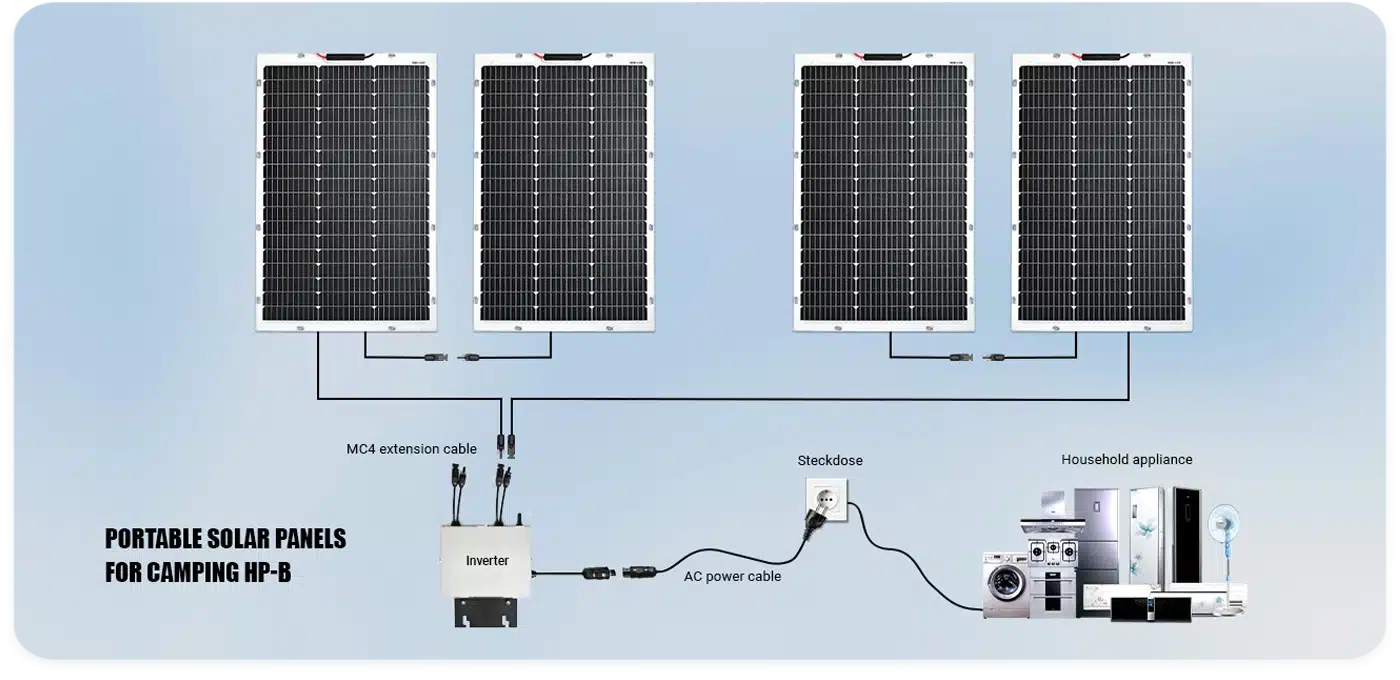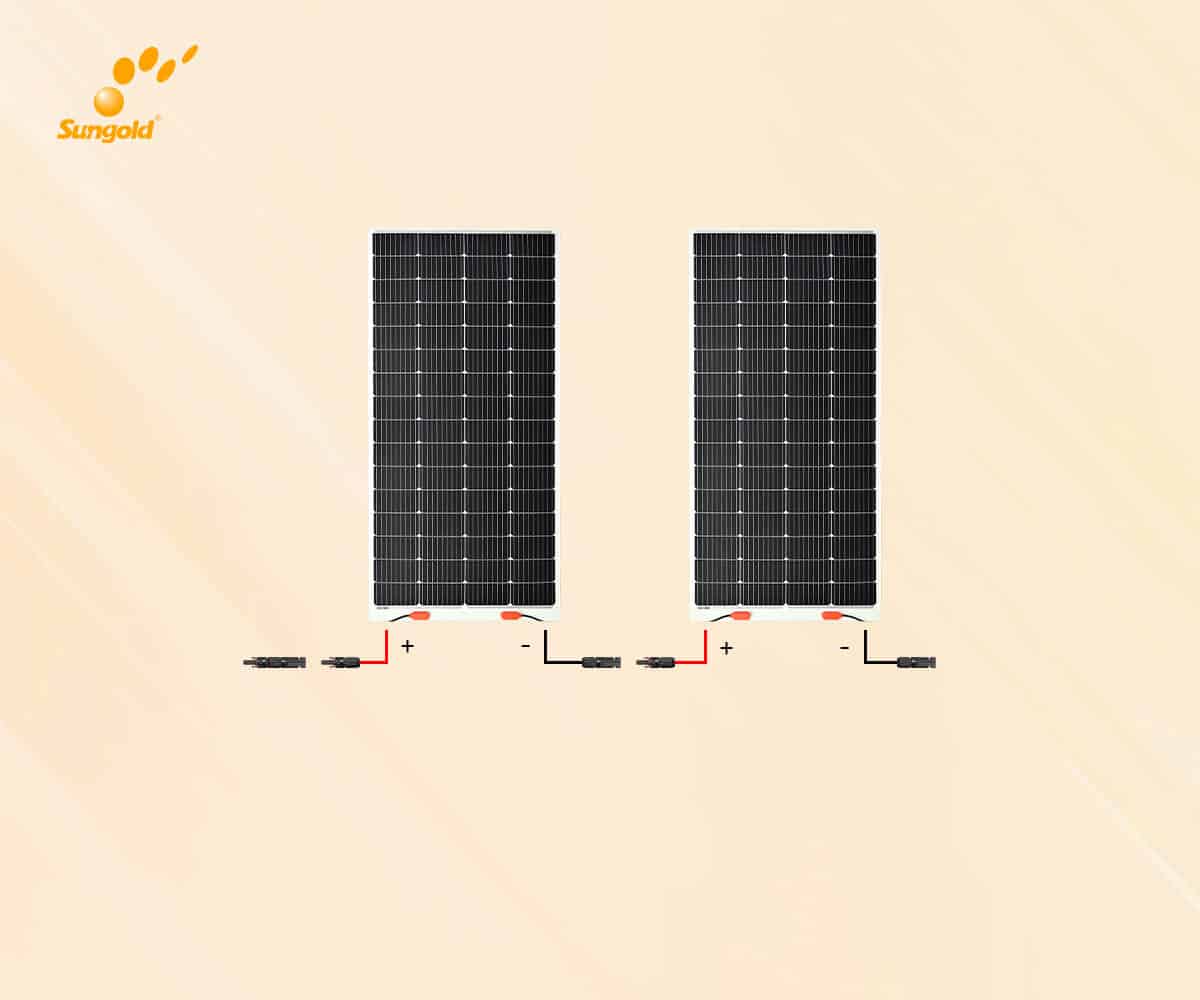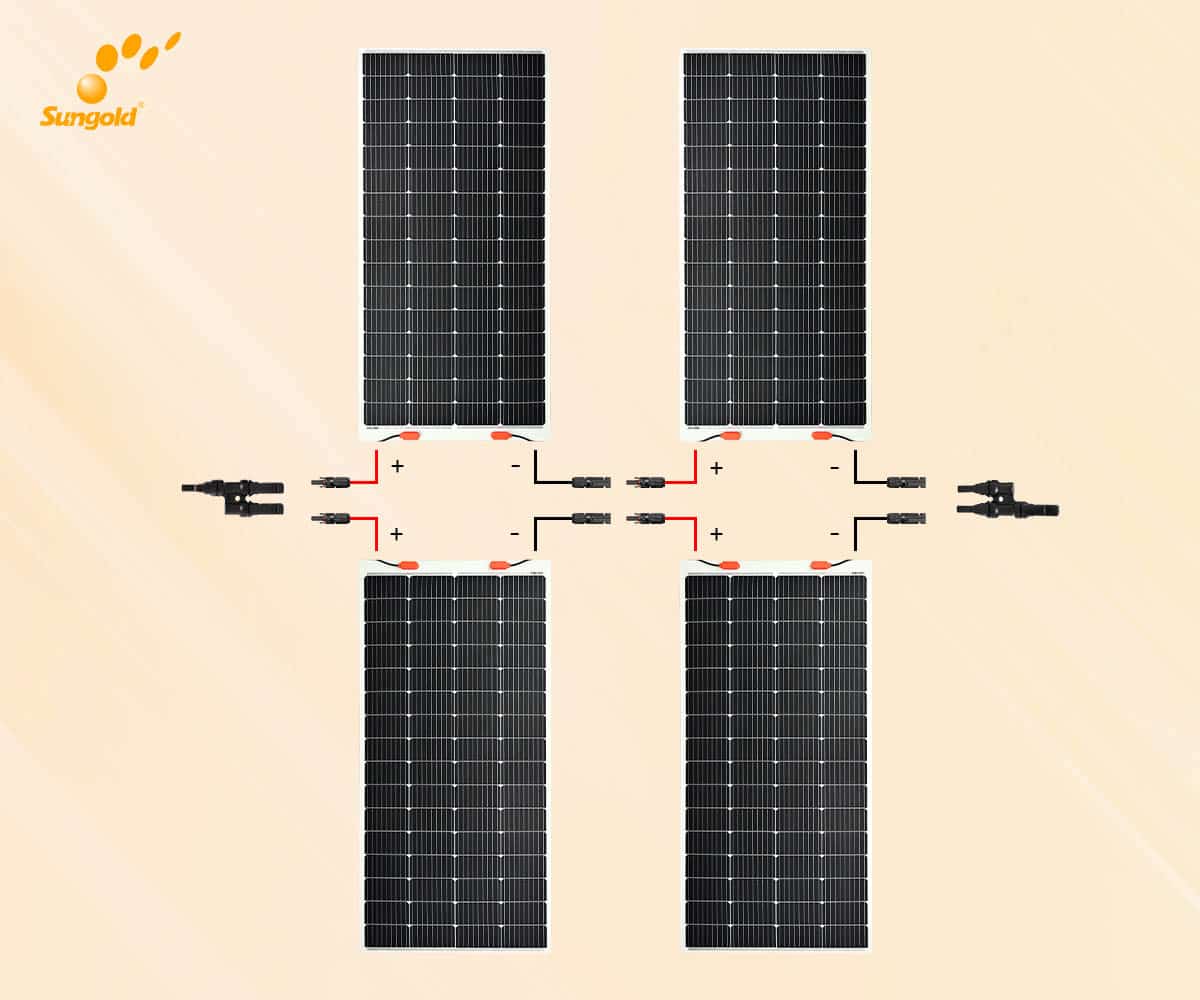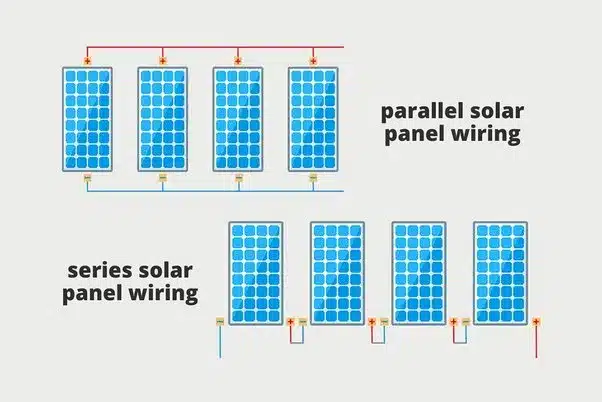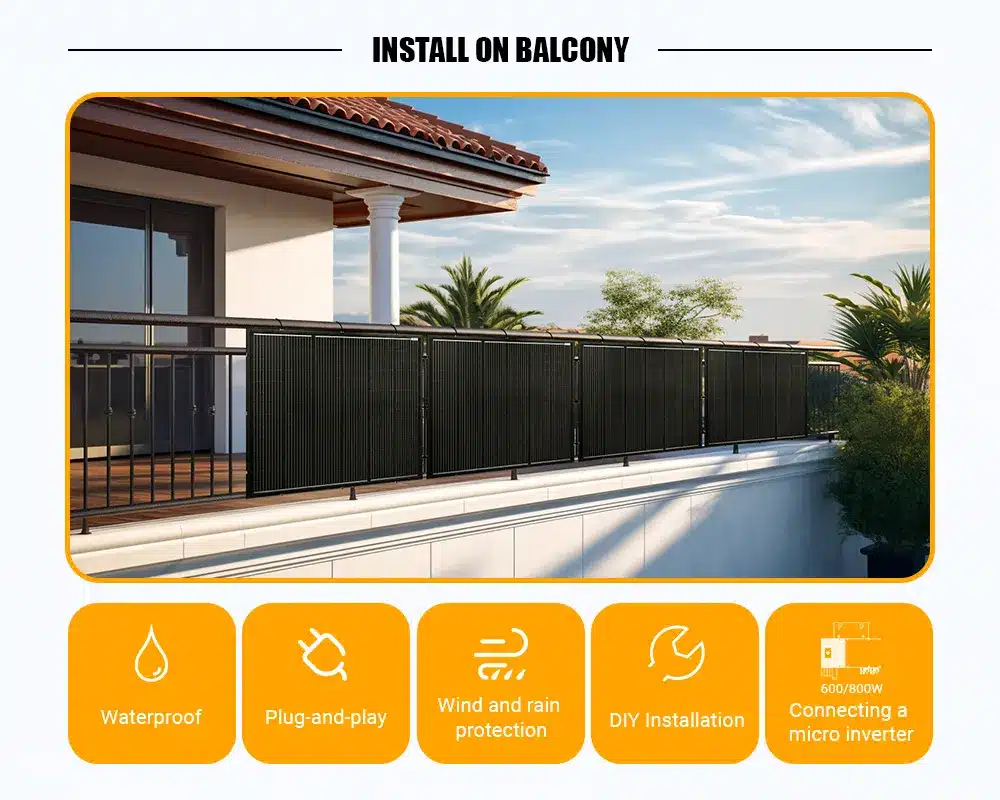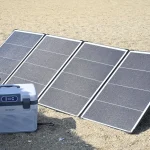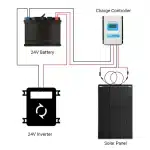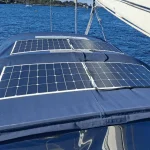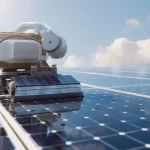The two common configurations for connecting solar panels are series and parallel. Before you can start reaping the great benefits of solar energy, you need to figure out which system setup is better suited for your energy needs.
For a quick explanation, the main difference between solar panels connected in series and parallel is the output voltage and output current. The output voltage of a series-connected solar panel adds up, while the output current (amperage) remains constant. On the other hand, solar panels connected in parallel will have an increased output current (increased amperage), but their output voltage will be the same. So, in short: for solar panels connected in series, you add up the voltages, while for solar panels connected in parallel, you add up the current strengths.
Key Terms to Remember
- Voltage – refers to the difference in electric potential (charge) between two points
- Current – it is the rate of charge (amount of electricity) that is flowing through a circuit
- Amperage – it is the unit used to measure electric current
- Output Voltage – this is the voltage that is released by a device, such as a generator or a voltage regulator
- Output Current – this refers to the maximum current that can be supplied to a load
Let us walk you through connecting solar panels in series and in parallel and choose what works better for you!
How do I wire a solar panel?
There are two key metrics to keep in mind when connecting solar panels: voltage and current. Any given solar power system has a minimum and maximum capacity. These limits affect how best to connect the panels together.
Different solar panels have different voltages and currents. You need to connect them to balance solar system to maximize the input without exceeding the maximum capacity of the power station or solar generator. Often, you will connect multiple solar panels to a single power station. The way the panels are connected to each other and the balance of the system affects how efficiently the solar array captures and stores energy.
Why Choose Parallel Connections?
In solar power systems, parallel connections are typically used for smaller, simpler setups, especially when paired with PWM controllers. By connecting your solar panels in parallel, you increase the current (amperage) while keeping the voltage the same. This method is commonly used in 12V systems, particularly when multiple panels are involved, as parallel connections ensure that the system maintains a 12V charging voltage.
However, parallel systems do have some downsides. High amperage can be difficult to transmit over long distances without using very thick cables. For example, a 1000W system might output more than 50 amps, which requires thick wires, especially if the panels are more than 10 feet from the controller. In such cases, you might need to use 4 AWG or thicker wires, which can be expensive in the long run. Additionally, parallel systems require extra components like branch connectors or a combiner box to ensure proper system functionality.
Why Choose Series Connections?
In contrast to parallel connections, series connections are typically used with MPPT controllers in smaller systems. When solar panels are connected in series, the voltage increases, while the current remains the same. The reason for using series connections with MPPT controllers is that MPPT controllers can handle higher voltage inputs and still charge your 12V or higher voltage batteries effectively. For example, Renogy MPPT controllers can accept input voltages of up to 100 volts, making series connections ideal for long-distance power transmission.
One of the main advantages of series connections is that they are much more efficient for transmitting power over long distances. For instance, if you connect four 100-watt Renogy panels in series, you can run the system for 100 feet with just a thin 14-gauge wire. This makes series connections a great choice when you need to minimize power loss over distance.
Why Choose a Series-Parallel Combination?
In many solar power systems, the main limiting factor is the charge controller. Charge controllers are designed to handle only a certain amount of amperage and voltage. For larger systems, combining series and parallel connections allows you to stay within the acceptable limits of both amperage and voltage, ensuring that your system operates efficiently without exceeding the capacity of the charge controller.
Total Current, Voltage, and Power Calculation
The overall current, voltage, and power depend on the specific connection configuration. In summary:
Series Connection: The current remains unchanged, while the voltage is cumulative.
Parallel Connection: The voltage remains unchanged, while the current is cumulative.
Series-Parallel Connection: The voltage of each series string is added, and the current of each series string is multiplied by the number of parallel strings.
What are series-connected solar panels and how do they work?
Solar panels in series are connected head to tail to form a chain configuration. In this setup, the positive terminal of one panel is connected to the negative terminal of the next panel, which increases the total system voltage, and with this configuration, the system voltage matters the total voltage of all the panels. If you have 5 panels with 12 volts each, the total voltage is 60 volts.
The current remains the same as the individual panels. This series connection is ideal when the goal is a higher system voltage, such as for grid-tied applications. Series-connected solar panels are great for not shade conditions and/or if you need a low-current system.
What are parallel solar panels and how do they work?
In a parallel configuration, solar panels are connected side-by-side with the positive terminals connected to each other and the negative terminals connected to each other. This setup allows the voltage to be the same as that of the individual panels while increasing the total current. A parallel connection will allow your solar panels to produce energy without exceeding the operating voltage limits of the generator inverter.
Parallel connections are useful when the goal is higher system current (such as in an off-grid or battery charging setup).
Solar Panels Series vs parallel: Pros and Cons
When deciding between series and parallel connection of solar panels, it is important to evaluate your specific needs and system requirements. The choice depends on a variety of factors, including voltage and current requirements, power output needs, available space and module compatibility.
Pros and Cons of Series Wiring
Pros
- Higher voltage means higher power output, allowing you to charge solar cells faster and store power for later.
- No need for bulky cables and components due to lower total amperage.
- Series connection reduces power loss due to long-distance transmission due to higher voltage.
- Ideal for unshaded areas, series connections are usually more efficient in low light conditions.
Cons
- The performance of a series configuration is determined by the worst performing panel, an obstruction or poor performance of one panel means they all perform poorly.
- This system requires a high voltage tolerant inverter.
Pros and Cons of parallel wiring
Pros
- The failure or poor performance of one panel will not affect the other panels, the impact on the whole system will be minimized.
- Ideal for small low voltage systems, e.g. caravans, balcony systems.
- Lower voltage means less potential electrical risk.
Cons
- Parallel systems require more wiring and more complex installations, requiring greater capacity.
- If panels are not identical, this can cause damage and reduce overall solar system efficiency.
Solar Panels Series vs parallel: which is better?
Now that we understand the difference between series and parallel solar panels, how do we really choose? Well, it really depends on your application scenario.
If your solar panels spend most of their time in an unshaded area, then series-connected solar panels are usually preferred. The main reason for this is that your solar panel system will be more efficient and perform better at the beginning and end of the day and on cloudy days. Batteries require a higher than standard voltage to charge, and parallel connection requires a higher capacity to operate, undoubtedly increasing our budget to buy more solar panels.
Paralleling solar panels isn’t necessarily a bad option either, if we build our solar system in series then you’ll also need NPPT charge controllers to make the system work, and MPPT charge controllers are generally more expensive, and maybe more of a budget for a small low voltage system. If you have an RV, boat for lighting, or simple low voltage electrical conditions, then choosing parallel must be a perfect decision. This type of low voltage solar system can be used with lower cost PWM charge controllers as a way to lower your budget.
Voltage and Current in Series and Parallel Solar Panels
Voltage is a measure of electrical potential or force. Amperage is the unit of current. An easy way to think about the relationship between the two is that voltage is the water pressure that pushes the water through the pipe, and amperage is the rate of flow of water through the pipe.
When connecting panels in series via solar panel connectors, the voltages of all panels are added together. This means that the total voltage increases while the current stays at the panel with the lowest current strength. In the case of water in a pipe, you increase the potential pressure, but not the actual water flow rate.
On the other hand, when connected in parallel, the current increases, but not the voltage. This means you increase the flow rate, but not the pressure.
When deciding whether to connect in series or in parallel, it is important to be aware of the voltage and current strengths of all panels as well as the requirements and limitations of the balance of the system, such as inverters, microinverters, solar cells, and charge controllers.
This way, you can determine the best way to wire your equipment to maximize power generation without exceeding the maximum that your solar power system can handle.
Ultimate
Understanding the difference between series and parallel connections of solar panels is critical to optimizing the performance of your solar system. Carefully evaluate your system requirements, power output needs and specific application to choose the right configuration.
Whether you choose to connect in series or in parallel, utilizing solar energy offers many benefits, including a reduced carbon footprint, energy independence and long-term cost savings. Embrace renewable energy and contribute to a sustainable future.
If you have any questions about solar panels in series versus parallel, you are welcome to contact our team at any time and we will answer your questions and provide you with the optimal solution for your needs, we have the best balcony solar panels and rv solutions.
Frequently asked questions about series vs parallel connection of solar panels
Which type of wiring works better – series or parallel?
No particular type of wiring is “better” overall than another. However, you may find that one type of wiring is better for your particular solar system. Different factors come into play here. For example, parallel solar panels operate independently of each other. They are best suited for partial light situations or when some of your panels may be in shadow for part of the day. Also, series wiring is better suited for sunny, open spaces where there is nothing to block the sun’s rays.
Can I mix series and parallel solar panels?
Yes, it is possible and common to mix series and parallel solar panels in a solar panel array. By combining the two wiring configurations, it is possible to create a solar panel array that meets the voltage and current requirements of your specific application. For example, multiple series strings can be connected in parallel if a higher voltage is required, while multiple parallel strings can be connected in series if a higher current is required.
However, it is important to ensure that the solar panels you connect have similar electrical characteristics, such as voltage and current ratings, to prevent mismatches from leading to reduced system efficiency or even damage to the panels. In addition, proper fuse and wiring sizes should be used to ensure safe and reliable operation of your solar panel array.
Can flexible solar panels be connected in series?
Connecting more than one flexible solar panel in series, in parallel or in a mixed-mode is an effective and easy way not only to build a cost-effective solar panel system but also helps us add more flexible solar panels in the future to meet our increasing daily needs for electricity.
Should 12V solar panels be wired in series or parallel?
Series wiring involves connecting multiple panels together so that the voltages are combined to increase the total output. On the other hand, parallel wiring involves connecting each panel directly to the battery or load, which increases the current output. Each method has its advantages depending on what you are looking for. Series wiring can be useful if you need to increase the voltage to a certain level, while parallel wiring can be helpful if you need to increase the current to power a larger load. Ultimately, the decision between series and parallel wiring depends on your specific needs and preferences.
Can you add more solar panels to an existing system?
Yes! Creating a comprehensive Tiny Houses energy system from the start helps ensure that you choose the components that best suit your needs. However, this isn’t always possible. You may not have the funds to invest in all the necessary equipment up front. It’s also common for people to underestimate their electricity needs, so they choose to expand their system later. If you think you might want to add to the system over time, choose an oversized inverter to accommodate future energy capture.
Do solar panels charge faster in series or parallel?
There is no definitive answer as to whether series or parallel wiring will charge your batteries faster. This is because there are many factors that affect charging speed. For example, if wired in parallel, the voltage is usually lower than when wired in series. By wiring in parallel, your panels must run at a higher consistency to maintain the minimum voltage required. This means that, in general, series wiring may mean faster charging times.
How to get free solar panels from the government 2023?
Everyone dreams of getting free solar panels from the government for their home or commercial property, but it’s far from simple. The truth is that there is no such thing as free solar panels from the government, but there are various incentives and programs that can reduce the cost of installing a solar system.


